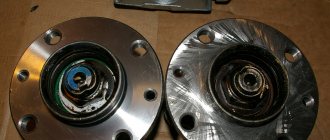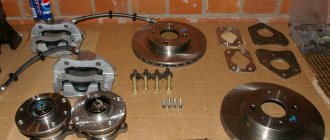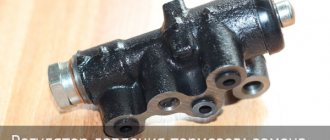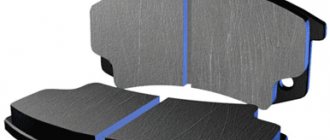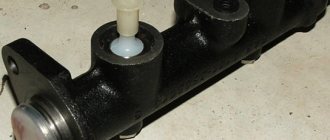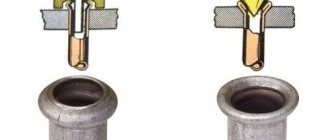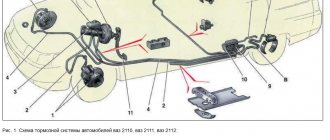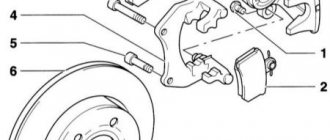Many cars have front brakes with disc brakes and rear brakes with drum brakes. But there are exceptions to this rule, and not only in auto racing, where all 4 wheels are equipped with disc brakes for the sake of reliability. Manufacturers in other countries equip only budget modifications of cars with drum systems; most of them have all disc brakes. But is it possible to equip a domestic car, for example, a Priora, with rear disc brakes and which ones are better?
pros
Let's look at why disc brakes are better than drum brakes:
- Braking becomes more reliable, braking distance is reduced;
- Braking forces are distributed more evenly, given that the VAZ 2110 is a front-wheel drive car;
- There is an effect of faster response after pressing the pedal;
- Unsprung masses are reduced;
- Heat dissipation occurs better, which is especially important when driving on a mountain road or during active acceleration/braking. For this reason, the brake system is cooled better;
- Disk ones are much easier to dismantle and replace;
- There is no need to adjust the handbrake after each repair of the rear brakes, although this will have to be done the first time;
- They do not freeze in winter after washing, like drum ones;
- Rear disc brakes installed on the VAZ 2110 are much more convenient to control and promptly notice pad wear.
This article will help you replace the rear brake pads if they are worn out:
Advantages
As mentioned above, on the VAZ 2110 rear brake discs have advantages over drum brakes. In particular, these are such advantages as:
Note. Improved heat dissipation is a very important factor, especially during active driving. In addition, this is relevant when driving at high speeds and on mountain roads.
- significant improvement in brake cooling;
- ease of installation and dismantling in case of replacement;
- brake discs eliminate the need to tighten the parking brake each time;
- reliability of these brakes;
- disc brakes, unlike drum brakes, do not freeze in winter after washing;
- ease of monitoring brake wear;
- an appearance that makes the car look like a sports car (you definitely can’t say the same about the VAZ 2110 with rear drum brakes).
Minuses
Replacing brakes with disc brakes was not without the famous “fly in the ointment,” although it rather concerns precisely those problems that their installation can cause.
Firstly, our law enforcement agencies consider their installation on a VAZ 2110 as a design change.
What might this entail?
Following:
- Fine when passing a technical inspection;
- You can be simply wrong in a controversial accident if traffic police officers emphasize that you have “wrong” brakes;
- And the insurance company may also consider this a reason for non-payment of insurance.
Secondly, the handbrake will additionally need to be modified - or replaced with a hydraulic handbrake, although the latter weakens over time.
An article containing step-by-step instructions for replacing the handbrake cable can be found here:
Thirdly, it is necessary to refine or carefully adjust the sorcerer so that on the VAZ 2110 the rear wheels do not brake more than the front ones, as this will certainly cause a skid, especially on ice or wet asphalt. To do this, sometimes you even have to grind down the pads by a quarter, or even more.
Bleeding and adjustment
After any manipulations with the brake system (it doesn’t matter whether you repaired the rear, front or parking), on a VAZ 2110 it is vitally important to bleed the brakes so that an air plug does not form anywhere in them, which can negate the ability to brake at the right moment.
It is convenient to do this together, but you can do it yourself, although this requires some additional equipment. Many people know how to bleed the brakes on a VAZ 2110. The main thing is not to forget to do this diagonally, always starting with the front wheels, and pump the right one first.
After bleeding, you still need to check the braking forces. This requires an outside observer. You accelerate and brake sharply, and he watches as the brakes apply. The front ones should work first, then (with a small gap) the rear ones, and the braking force should be greater for the front ones.
Everyone knows that the rear brakes of the VAZ 2110 are drum brakes . I don’t think it’s worth talking about the fact that these are brakes from the 40s.

